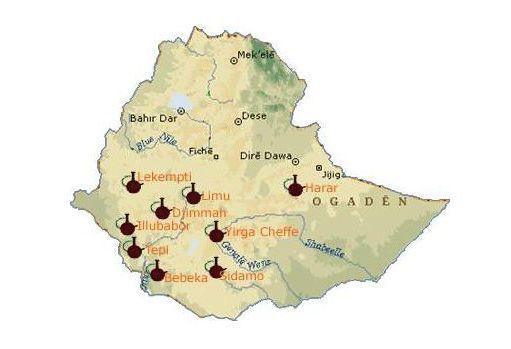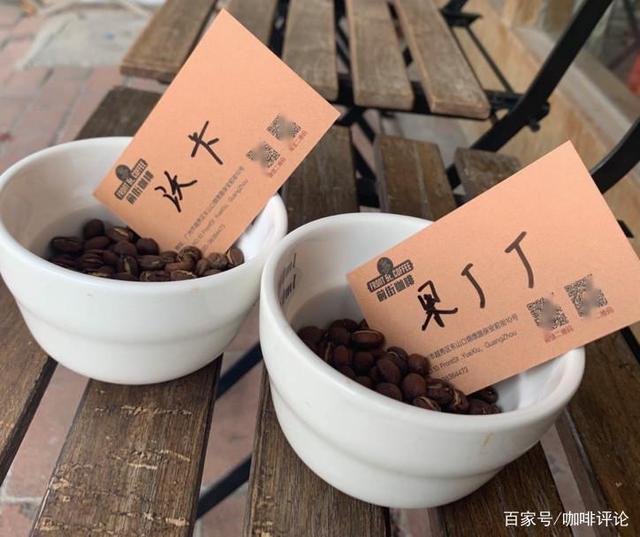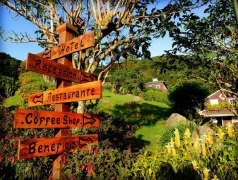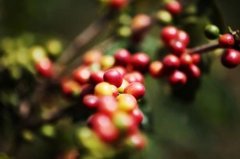What coffee producing areas are there in Ethiopia? What's the taste of boutique hand-made coffee beans?
There are two main boutique coffee producing areas in Ethiopia, one is Yegashafi and the other is Sidamo. Strictly speaking, Yegashafi is a by-product area of Sidamo. This town is located in the northwest of Sidamo, with a mountain and a lake. It is one of the highest coffee producing areas in Ethiopia on average, but because of its unique flavor, it is independent from Sidamo and has become the most famous producing area in Africa. Today, let's talk about Yega Xuefei's boutique coffee beans. Yega Xuefei has two cooperatives that have been very popular in recent years, namely, the Waka Cooperative and the Guoding Cooperative.

Waka Cooperative
Woka Cooperative's Sun Yega Chuefei has always been a quality assurance, and it is also the star product of Counter Culture and Klatch Coffee, the third wave of boutique coffee makers in the United States. Coffee Review, a well-known boutique coffee evaluation website, has repeatedly given high scores of 91 to 94.
Klatch Coffee, a well-known American company, won the Best Food Award (Good Food Award) in the food industry for this bean, and won the title of Best Coffee Shop of 2012 (2012 Best Coffeehouse) at the end of the year. The Waka Cooperative, which is part of the YCFCU Cooperative Alliance (Yirgacheffe Coffee Farmers Cooperative Union), was founded in 2005 and is located in a rather remote area of the Yegashafi producing area.
The cooperative, made up of 305 farmers with a planting area of 763 hectares, has obtained Fair Trade Organic Coffee (FTO) certification because it does not use any chemical fertilizers or pesticides in its coffee growing process. After the ripe cherries are picked, they are almost immediately put on the drying shed bed for sunlight, so that the sweetness of the flesh can be absorbed by beans. Sun treatment is especially suitable for areas where there is a lack of water, or in a very dry environment. In order to avoid excessive fermentation or even mildew, the fruit must be turned frequently on the drying bed to allow air to dry evenly, when the fruit is dried in the sun. Then sent to the dry processing plant (dry mill) to remove the dried pulp, the sun drying procedure is actually quite complicated, and it is easy to fail in the process, but good sun treatment can bring stronger sweetness, thicker taste and more detailed sour taste.
The Godding Cooperative, located in the Waka producing area at the southeast end of Yega Sheffield, was originally part of the Waka Cooperative under the YCFCU of the Yega Sheffield Alliance.
But later, with the pursuit of traceability of raw coffee beans, independent "single producing areas" were excavated by coffee hunters all over the world, so in 2012, Guoding Ding, which has about 300 farmers, was independently established.
Guodingding Village was the first independent village area, and many small farmers were also members of the Waka Cooperative, so the technology of producing coffee was not to mention. Guodingding Cooperative is known as the last piece of pure land of Yejia Xuefei, so the raw bean treatment is also a very traditional way of treatment.
So what's the difference between them?

There are lemon, plum and Tieguanyin at the entrance of "Yejia Shifeiwaka". Under the change of temperature, the taste of caramel is obvious, the acidity is bright, and the taste is obvious.
"Yejia Xuefei Fruit Ding Ding" has citrus and black tea at the entrance. With the change of temperature, there are cream, caramel and almond aftertaste and taste clean and sweet.
In terms of the taste of cooking, the tea taste of "Yega Sheffield Woka" and "Yega Sheffield Ding Ding" is more prominent. "Yega Sheffield Woca" has a rich caramel flavor, bright and clean acidity, and "Yega Sheffield Guoding Ding" tastes clean and sweet.
Important Notice :
前街咖啡 FrontStreet Coffee has moved to new addredd:
FrontStreet Coffee Address: 315,Donghua East Road,GuangZhou
Tel:020 38364473
- Prev

The variety and flavor of coffee beans in Brazil, the world's largest producer of coffee beans, have originated.
Brazil is the largest producer of coffee beans in the world. Brazil has 21 states and 17 states produce coffee, but four of them produce the largest, accounting for 98% of the country's total output. Brazilian coffee has a low sour taste, coupled with the sweet and bitter taste of coffee, the entrance is very smooth, but also with a hint of grass aroma, slightly bitter in the fragrance, smooth and smooth in the aftertaste
- Next

The origin story of Kenyan coffee, whether Kenyan hand-made coffee tastes good, flavor evaluation.
The Republic of Kenya (The Republic of Kenya) is located in eastern Africa, the equator runs through the central part, and the Great Rift Valley of East Africa runs through the north and south. It is bordered by Somalia to the east, Tanzania to the south, Uganda to the west, Ethiopia and South Sudan to the north, and the Indian Ocean to the southeast. The coastline is 536 km long. 18% of the land area is arable land, and the rest is mainly suitable for animal husbandry. As coffee.
Related
- Beginners will see the "Coffee pull flower" guide!
- What is the difference between ice blog purified milk and ordinary milk coffee?
- Why is the Philippines the largest producer of crops in Liberia?
- For coffee extraction, should the fine powder be retained?
- How does extracted espresso fill pressed powder? How much strength does it take to press the powder?
- How to make jasmine cold extract coffee? Is the jasmine + latte good?
- Will this little toy really make the coffee taste better? How does Lily Drip affect coffee extraction?
- Will the action of slapping the filter cup also affect coffee extraction?
- What's the difference between powder-to-water ratio and powder-to-liquid ratio?
- What is the Ethiopian local species? What does it have to do with Heirloom native species?

